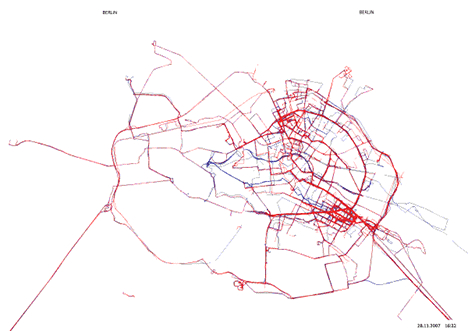DANIEL BELASCO ROGERS
How is GPS data stored and how does it look like?
It can take many forms but it is very simple, it just consists of the longitude, latitude, date and time, altitude and a flag that tells if there was GPS reception since the last point. This can be presented as text.
How many points do you generate a day?
This is very changeable. It is dependent on how we have set the GPSs that we carry and what we are doing. You can set them to record a trackpoint every second but we don’t often do that as they get full too quickly. On this setting, you can only record 2.5 hours of material. If we are in Berlin and just moving around as we normally do and the GPS is set to an average level of point recording, I download the tracks every two weeks before they overwrite themselves.
How many cities have you been tracking so far?
I’ve only analysed the data for 2007 like this – I wouldn’t like to guess how many places I’ve visited since 2003 because our work takes us to lots of different towns and cities. It also depends what you define as a city. In 2007 alone, we visited approximately 32 cities and towns.
Why do you think is so engaging to look at the generated maps?
This is a question I asked myself at the beginning: I can stare at my own tracks for hours but are they engaging for anyone else? By exhibiting and talking about the work in a number of contexts, it became clear that a lot of people were interested in them too. I think there could be a number of reasons and I believe it is a mixture between interpreting the drawings as maps that show where one individual spends his time – if you know the city you can tell this and a reflecting on one’s own movements. A lot of people think that the maps of their lives would be boring but I hope to show that this is not true.
Are you planning to do something else with the GPS data that you are collecting?
We are starting to make animations of the lines drawing themselves. To do this we are collaborating with Andreas Schlegel, an artist, lecturer and software designer I met in Tokyo who has is very knowledgeable about Processing, an open source programming language.

Do the tracks bring memories to you? Do you somehow feel emotionally attached to them?
When you look at a map of a city I am in a lot like Berlin, there are lines that are very thick because of a combination between GPS (in)accuracy and the fact that I go that way almost everyday. Of course these, familiar lines are the hardest to read back like this which is interesting because it makes me think about how much you really remember your daily journeys, how conscious they are. However, there will be some lines that are one or two lines thick and these I can read back as memorable trips. To answer quickly, I feel very emotionally attached to them because it makes me feel very mortal. This is the drawing of my life, not the one I fantasize but a very real, sometimes boring, sometimes exciting, collection of everywhere I go. It’s kind of defining, kind of frightening and also kind of liberating.
Read more ...





